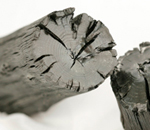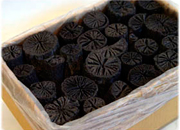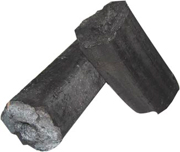

| 1 | History of Sumi / Characteristic of Sumi |
Characteristic of Sumi2 >
~Sumi is a gift from nature~
umi, which is full of the healing power of wood, helps our life and creates a space that makes us feel peaceful and ease of mind and body. Care for the Sumi charcoal we provide is done by tracing back to where and when the Sumi charcoal or binchotan was made and in which kiln of which mountain by whom was it made with which formula and so forth. As for its rareness, binchotan has started to be called 'diamond in wood' recently. The logs of Ubamegashi, have become very precious wood for charcoal because of logging. The binchotan is a gift from nature which was made with great care and love after the conservation of nature. We keep the binchotan and deliver it to you with our offer plan that will meet your individual needs with a combination of the wisdom of our ancestors from ancient times and modern technology.
■Common characteristics of Sumi
<Hakutan and Kokutan>
Hakutan or white charcoal
Carbonized equally at high temperature of 1,000 degrees Celsius, we take out the incandescent charcoal and cool it down quickly. Therefore, it became hard and has metallic sound when hit. The chilled charcoal is covered with white ashes. So, it is called white charcoal, or hakutan. A typical example of white charcoal is binchotan.
Kokutan or black charcoal
This Sumi is carbonized between 400 and 700 degrees Celsius, and then cooled down slowly in the kiln. When it is used for the tea ceremony it is easy to ignite and user-friendly. An example of kokutan is Kunugi-sumi for the tea ceremony which is well known.
■Common characteristics of Sumi
Binchotan

Binchotan is the most well known kind of hakutan which is made from Ubamegashi. The name came from Bicchuya Chozaemon, a charcoal dealer of Kishu in the Edo period (1600 – 1868 AD), who improved the Yuyatan charcoal method which had been produced in Kumano district in south Kishu since Heian period (794 – 1180 AD) and started selling it.
It's been used as a heat source when other energy sources did not exist. The burning duration is long and easy to maintain the temperature. It is called 'black diamond' nowadays, and being used also for purification and adjusting humidity. It is becoming more common to be used as a luxury interior display. Kishu in Wakayama prefecture and Tosa in Kochi prefecture are well known production areas.
Kunugi-sumi

Kunugi-sumi is the highest class of all kokutan charcoal used in the tea ceremony. It is easy to ignite and burns powerfully. It is made from the kunugi tree, a broad-leaf tree. As it does not smell when burned, it is suitable for a hibachi brazier, for heating and cooking. The well known Kunugi-sumi, used for 'sumi-temae' which has a long tradition and has been established in the healing culture of Japan, is Ikeda-sumi from Osaka prefecture and Sakura-sumi from Chiba prefecture, and they are the best known of all charcoals for the tea ceremony.
Oga-sumi or sawdust charcoal

Solidified sawdust is burned in high temperature in the same way as hakutan, and is molded with a hole in the center. It is easier to ignite than binchotan and has a longer burning duration than kunugi-sumi. Improvements have been made to supply Oga-sumi at a cheaper price and to perform as well as hakutan, and are used in a restaurant kitchen.
Nara-sumi or Japanese oak charcoal
When we speak of Sumi charcoal, it usually refers to nara-sumi. It used to be employed for heating, and is popular to be used for barbecues these days. Nara-sumi is made from a kind of broad-leaf tree. Iwate prefecture is a famous production area and has the world’s largest output.
It is easy to ignite for its hardness compared to kunugi-sumi and is a universally user-friendly charcoal.
Special use charcoal
Special use charcoal refers to Hoonoki-zumi, Suruga-zumi and Roiro-zumi charcoal. They are used for polishing lacquer wear.
<Imported charcoal>
Mangrove charcoal
These are available at an economical price and easy to ignite. They have good cost performance, but are being used at limited places and for limited purposes because of its acidic smell. It is imported from Malaysia, Indonesia and Thailand.
Yasigara-sumi or palm shell charcoal
Made from palm fruit or palm tree and burned in high temperatures. Used as a material for activated charcoal. It is made in the Philippines.
<Other kinds of charcoal>
Activated charcoal
Carbonized palm shells are commonly distributed as an activated charcoal. Research and development for the usage of industry and high-tech industry is expected. As it has lots of pores and powerful absorption, used as a deodorizer for refrigerators, water cleaners, tobacco filters, shoe insoles and architecture.
Back to the top on this page
History of Sumi / Characteristic of Sumi / Renovating Your Space